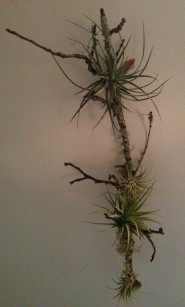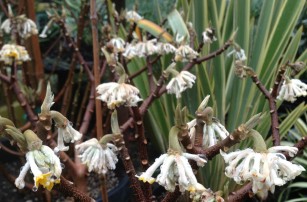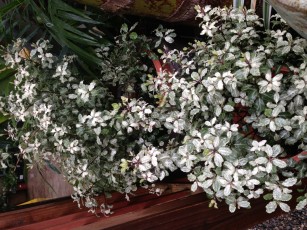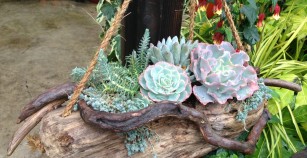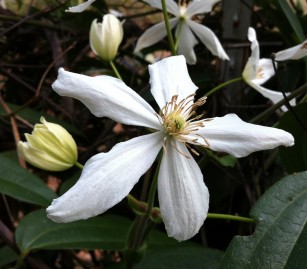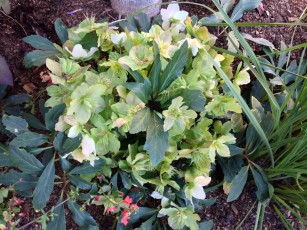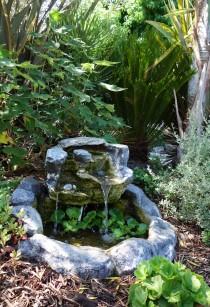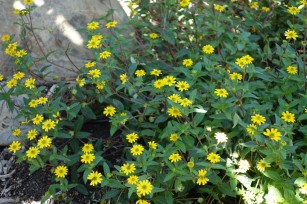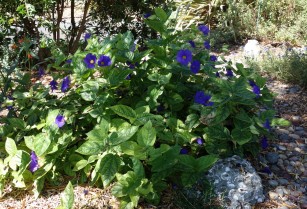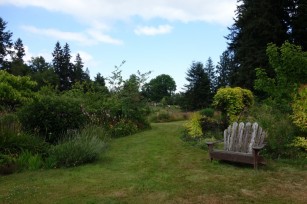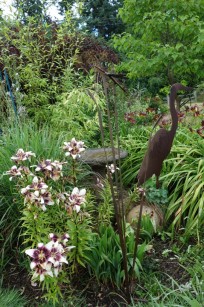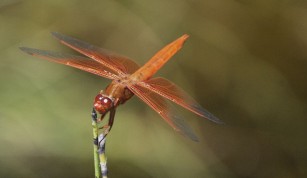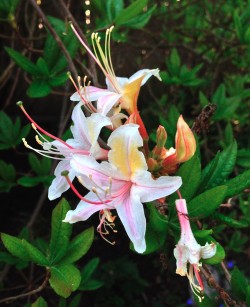 When I visit my best friend’s house I park next to the perennial border that lines her driveway. At any given time of year there is something blooming, flowers filling the air with fragrance and juicy apples hanging on the tree for picking later in the summertime. She has some California natives as well as traditional cottage garden plants all mixed in together. Originally from Illinois, she loves a garden filled with lush green and color but has designed the space with plants that can use less water than you would expect and still look spectacular.
When I visit my best friend’s house I park next to the perennial border that lines her driveway. At any given time of year there is something blooming, flowers filling the air with fragrance and juicy apples hanging on the tree for picking later in the summertime. She has some California natives as well as traditional cottage garden plants all mixed in together. Originally from Illinois, she loves a garden filled with lush green and color but has designed the space with plants that can use less water than you would expect and still look spectacular.
What makes for a successful border? You see DIY articles in the gardening magazines showing lovely combinations with rules to follow but they always seem to be for a different climate or location. We often have borrowed scenery from the mixed woods and some of their ideas just don’t work well here. Here are some tips for planting a terrific perennial border in our neck of the woods.
Some of the key players in my friends perennial border are natives like Western azalea, 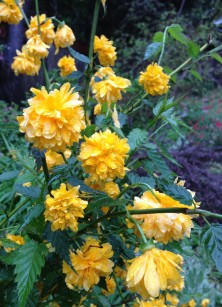 hazelnut and flowering currant. These are large, woody shrubs that add height, texture and year round interest. They provide the backbone or structure to the border throughout the seasons and even in the winter. She also has a weeping bottlebrush which is evergreen and provides nectar for the hummingbirds as does the flowering currant. An apple tree and a persimmon tower over all the other plants creating a canopy for the shrubs, herbaceous perennials and groundcovers. You could also plant spirea, weigela, cornus and viburnums to provide structure to your border.
hazelnut and flowering currant. These are large, woody shrubs that add height, texture and year round interest. They provide the backbone or structure to the border throughout the seasons and even in the winter. She also has a weeping bottlebrush which is evergreen and provides nectar for the hummingbirds as does the flowering currant. An apple tree and a persimmon tower over all the other plants creating a canopy for the shrubs, herbaceous perennials and groundcovers. You could also plant spirea, weigela, cornus and viburnums to provide structure to your border.
My friend’s border is planted so that there is something of interest every month during the growing season. The persimmon tree is the star of the late fall garden with bright orange fruit that hang like ornaments on the tree. In the spring I can’t take my eyes off the kerria japonica whose graceful shape is covered with double golden, pom pom shaped flowers. The vivid, new foliage of the Rose Glow barberry complements the stand of Pacific coast iris with similar cream and burgundy flowers blooming next to it.? Under the bottlebrush a sweep of billbergia nutans or Queen’s Tears is flowering with those exotic looking, drooping flower clusters. They make a great groundcover under the tree and also are long lasting in a vase.
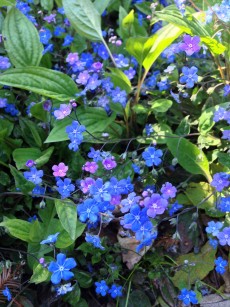 Mid-sized filler plants that thrive in this border include Hot Lips salvia, daylilies and polemonium to name just a few. Daffodils and tulips have naturalized throughout the space. Groundcovers grow thickly to shade the soil and prevent precious moisture evaporation.? Lamb’s ears like their spot under the flowering currant and the omphalodes have spread throughout the border. This little plant looks and blooms like the forget-me-not but the delicate deep blue flowers don’t produce those sticky seeds that plague both our socks and animal fur.
Mid-sized filler plants that thrive in this border include Hot Lips salvia, daylilies and polemonium to name just a few. Daffodils and tulips have naturalized throughout the space. Groundcovers grow thickly to shade the soil and prevent precious moisture evaporation.? Lamb’s ears like their spot under the flowering currant and the omphalodes have spread throughout the border. This little plant looks and blooms like the forget-me-not but the delicate deep blue flowers don’t produce those sticky seeds that plague both our socks and animal fur.
This border get morning sun and mid-afternoon sun until about 3pm. If you have a situation that calls for all sun lovers you could try asters, shasta daisy, grasses, coreopsis, achillea, echinacea, gaillardia, sedum, kniphofia, lavender, liatris and rudbeckia.? Perennials that work well to attract butterflies and hummingbirds include monarda and my personal favorite, cardinal flower.? Both have long, tubular flowers in bright colors such as red, orange and yellow. it’s easy to have the birds and butterflies coming all season when you plant perennials with overlapping bloom times.
Perhaps some of these plant combinations would look great in your garden, too. Just don’t worry too much about the “rules” of perennial borders. Mix it up. You don’t want the border to look like stadium seating. The idea is to have fun and create a border that makes you happy.

